Shaohua Pan
A majorized PAM method with subspace correction for low-rank composite factorization model
Jun 07, 2024



Abstract:This paper concerns a class of low-rank composite factorization models arising from matrix completion. For this nonconvex and nonsmooth optimization problem, we propose a proximal alternating minimization algorithm (PAMA) with subspace correction, in which a subspace correction step is imposed on every proximal subproblem so as to guarantee that the corrected proximal subproblem has a closed-form solution. For this subspace correction PAMA, we prove the subsequence convergence of the iterate sequence, and establish the convergence of the whole iterate sequence and the column subspace sequences of factor pairs under the KL property of objective function and a restrictive condition that holds automatically for the column $\ell_{2,0}$-norm function. Numerical comparison with the proximal alternating linearized minimization method on one-bit matrix completion problems indicates that PAMA has an advantage in seeking lower relative error within less time.
Fusing Monocular Images and Sparse IMU Signals for Real-time Human Motion Capture
Sep 01, 2023Abstract:Either RGB images or inertial signals have been used for the task of motion capture (mocap), but combining them together is a new and interesting topic. We believe that the combination is complementary and able to solve the inherent difficulties of using one modality input, including occlusions, extreme lighting/texture, and out-of-view for visual mocap and global drifts for inertial mocap. To this end, we propose a method that fuses monocular images and sparse IMUs for real-time human motion capture. Our method contains a dual coordinate strategy to fully explore the IMU signals with different goals in motion capture. To be specific, besides one branch transforming the IMU signals to the camera coordinate system to combine with the image information, there is another branch to learn from the IMU signals in the body root coordinate system to better estimate body poses. Furthermore, a hidden state feedback mechanism is proposed for both two branches to compensate for their own drawbacks in extreme input cases. Thus our method can easily switch between the two kinds of signals or combine them in different cases to achieve a robust mocap. %The two divided parts can help each other for better mocap results under different conditions. Quantitative and qualitative results demonstrate that by delicately designing the fusion method, our technique significantly outperforms the state-of-the-art vision, IMU, and combined methods on both global orientation and local pose estimation. Our codes are available for research at https://shaohua-pan.github.io/robustcap-page/.
EgoLocate: Real-time Motion Capture, Localization, and Mapping with Sparse Body-mounted Sensors
May 02, 2023Abstract:Human and environment sensing are two important topics in Computer Vision and Graphics. Human motion is often captured by inertial sensors, while the environment is mostly reconstructed using cameras. We integrate the two techniques together in EgoLocate, a system that simultaneously performs human motion capture (mocap), localization, and mapping in real time from sparse body-mounted sensors, including 6 inertial measurement units (IMUs) and a monocular phone camera. On one hand, inertial mocap suffers from large translation drift due to the lack of the global positioning signal. EgoLocate leverages image-based simultaneous localization and mapping (SLAM) techniques to locate the human in the reconstructed scene. On the other hand, SLAM often fails when the visual feature is poor. EgoLocate involves inertial mocap to provide a strong prior for the camera motion. Experiments show that localization, a key challenge for both two fields, is largely improved by our technique, compared with the state of the art of the two fields. Our codes are available for research at https://xinyu-yi.github.io/EgoLocate/.
An inexact linearized proximal algorithm for a class of DC composite optimization problems and applications
Mar 29, 2023Abstract:This paper is concerned with a class of DC composite optimization problems which, as an extension of the convex composite optimization problem and the DC program with nonsmooth components, often arises from robust factorization models of low-rank matrix recovery. For this class of nonconvex and nonsmooth problems, we propose an inexact linearized proximal algorithm (iLPA) which in each step computes an inexact minimizer of a strongly convex majorization constructed by the partial linearization of their objective functions. The generated iterate sequence is shown to be convergent under the Kurdyka-{\L}ojasiewicz (KL) property of a potential function, and the convergence admits a local R-linear rate if the potential function has the KL property of exponent $1/2$ at the limit point. For the latter assumption, we provide a verifiable condition by leveraging the composite structure, and clarify its relation with the regularity used for the convex composite optimization. Finally, the proposed iLPA is applied to a robust factorization model for matrix completions with outliers, DC programs with nonsmooth components, and $\ell_1$-norm exact penalty of DC constrained programs, and numerical comparison with the existing algorithms confirms the superiority of our iLPA in computing time and quality of solutions.
Column $\ell_{2,0}$-norm regularized factorization model of low-rank matrix recovery and its computation
Aug 24, 2020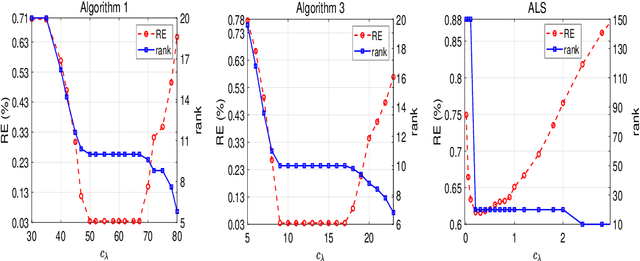
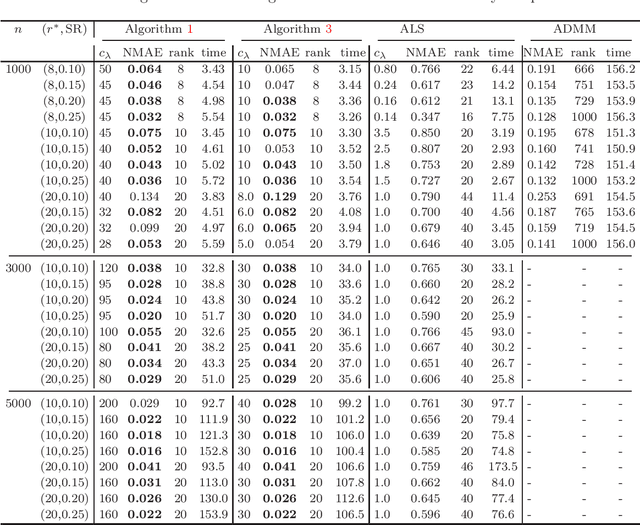
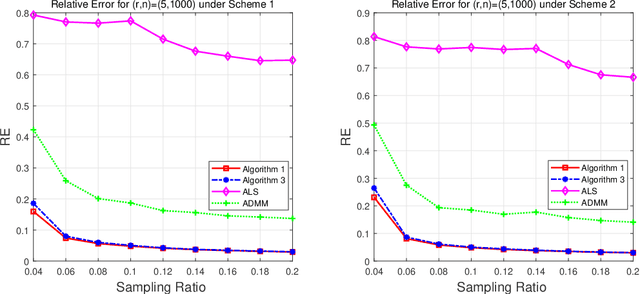
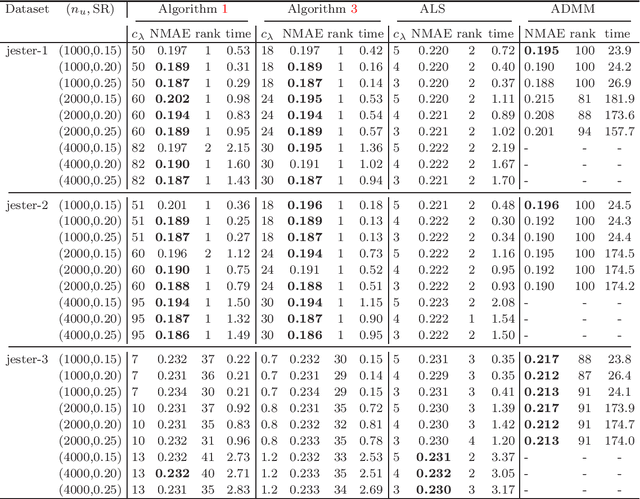
Abstract:This paper is concerned with the column $\ell_{2,0}$-regularized factorization model of low-rank matrix recovery problems and its computation. The column $\ell_{2,0}$-norm of factor matrices is introduced to promote column sparsity of factors and lower rank solutions. For this nonconvex nonsmooth and non-Lipschitz problem, we develop an alternating majorization-minimization (AMM) method with extrapolation, and a hybrid AMM in which a majorized alternating proximal method is first proposed to seek an initial factor pair with less nonzero columns and then the AMM with extrapolation is applied to the minimization of smooth nonconvex loss. We provide the global convergence analysis for the proposed AMM methods and apply them to the matrix completion problem with non-uniform sampling schemes. Numerical experiments are conducted with synthetic and real data examples, and comparison results with the nuclear-norm regularized factorization model and the max-norm regularized convex model demonstrate that the column $\ell_{2,0}$-regularized factorization model has an advantage in offering solutions of lower error and rank within less time.
Error bound of local minima and KL property of exponent 1/2 for squared F-norm regularized factorization
Nov 11, 2019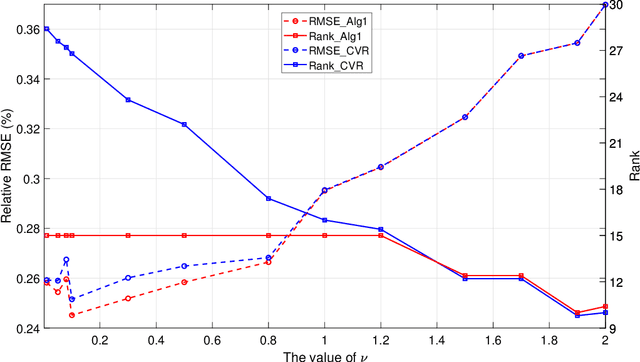
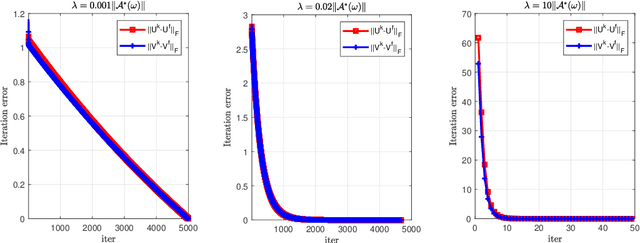
Abstract:This paper is concerned with the squared F(robenius)-norm regularized factorization form for noisy low-rank matrix recovery problems. Under a suitable assumption on the restricted condition number of the Hessian matrix of the loss function, we establish an error bound to the true matrix for those local minima whose ranks are not more than the rank of the true matrix. Then, for the least squares loss function, we achieve the KL property of exponent 1/2 for the F-norm regularized factorization function over its global minimum set under a restricted strong convexity assumption. These theoretical findings are also confirmed by applying an accelerated alternating minimization method to the F-norm regularized factorization problem.
KL property of exponent $1/2$ of $\ell_{2,0}$-norm and DC regularized factorizations for low-rank matrix recovery
Aug 24, 2019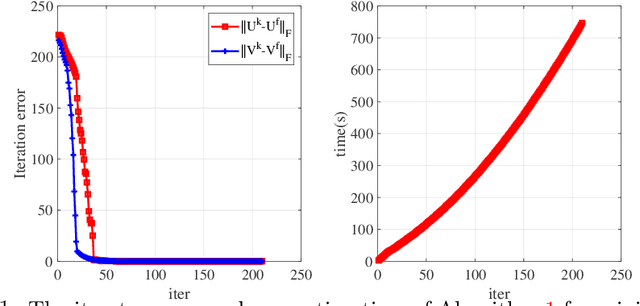
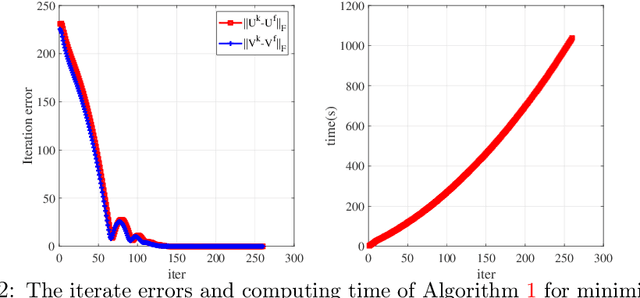
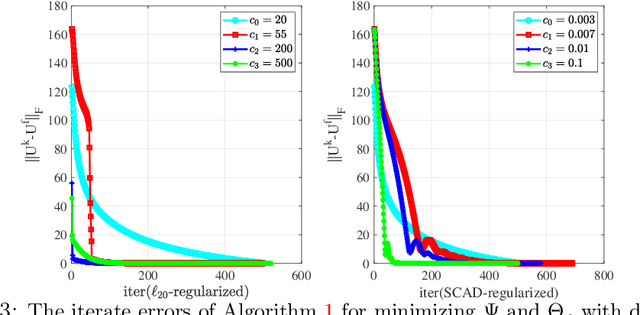
Abstract:This paper is concerned with the factorization form of the rank regularized loss minimization problem. To cater for the scenario in which only a coarse estimation is available for the rank of the true matrix, an $\ell_{2,0}$-norm regularized term is added to the factored loss function to reduce the rank adaptively; and account for the ambiguities in the factorization, a balanced term is then introduced. For the least squares loss, under a restricted condition number assumption on the sampling operator, we establish the KL property of exponent $1/2$ of the nonsmooth factored composite function and its equivalent DC reformulations in the set of their global minimizers. We also confirm the theoretical findings by applying a proximal linearized alternating minimization method to the regularized factorizations.
Equivalent Lipschitz surrogates for zero-norm and rank optimization problems
Apr 30, 2018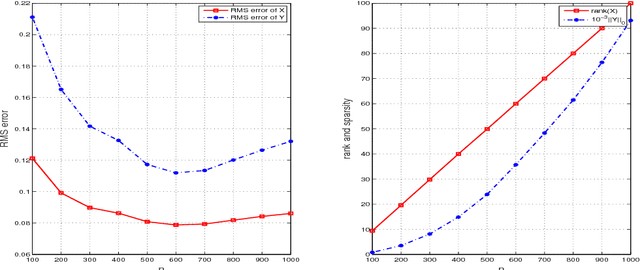
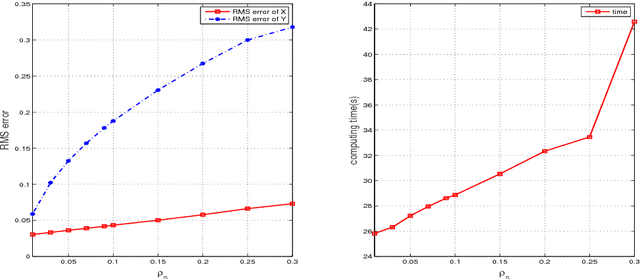
Abstract:This paper proposes a mechanism to produce equivalent Lipschitz surrogates for zero-norm and rank optimization problems by means of the global exact penalty for their equivalent mathematical programs with an equilibrium constraint (MPECs). Specifically, we reformulate these combinatorial problems as equivalent MPECs by the variational characterization of the zero-norm and rank function, show that their penalized problems, yielded by moving the equilibrium constraint into the objective, are the global exact penalization, and obtain the equivalent Lipschitz surrogates by eliminating the dual variable in the global exact penalty. These surrogates, including the popular SCAD function in statistics, are also difference of two convex functions (D.C.) if the function and constraint set involved in zero-norm and rank optimization problems are convex. We illustrate an application by designing a multi-stage convex relaxation approach to the rank plus zero-norm regularized minimization problem.
A Rank-Corrected Procedure for Matrix Completion with Fixed Basis Coefficients
Jun 22, 2015



Abstract:For the problems of low-rank matrix completion, the efficiency of the widely-used nuclear norm technique may be challenged under many circumstances, especially when certain basis coefficients are fixed, for example, the low-rank correlation matrix completion in various fields such as the financial market and the low-rank density matrix completion from the quantum state tomography. To seek a solution of high recovery quality beyond the reach of the nuclear norm, in this paper, we propose a rank-corrected procedure using a nuclear semi-norm to generate a new estimator. For this new estimator, we establish a non-asymptotic recovery error bound. More importantly, we quantify the reduction of the recovery error bound for this rank-corrected procedure. Compared with the one obtained for the nuclear norm penalized least squares estimator, this reduction can be substantial (around 50%). We also provide necessary and sufficient conditions for rank consistency in the sense of Bach (2008). Very interestingly, these conditions are highly related to the concept of constraint nondegeneracy in matrix optimization. As a byproduct, our results provide a theoretical foundation for the majorized penalty method of Gao and Sun (2010) and Gao (2010) for structured low-rank matrix optimization problems. Extensive numerical experiments demonstrate that our proposed rank-corrected procedure can simultaneously achieve a high recovery accuracy and capture the low-rank structure.
 Add to Chrome
Add to Chrome Add to Firefox
Add to Firefox Add to Edge
Add to Edge